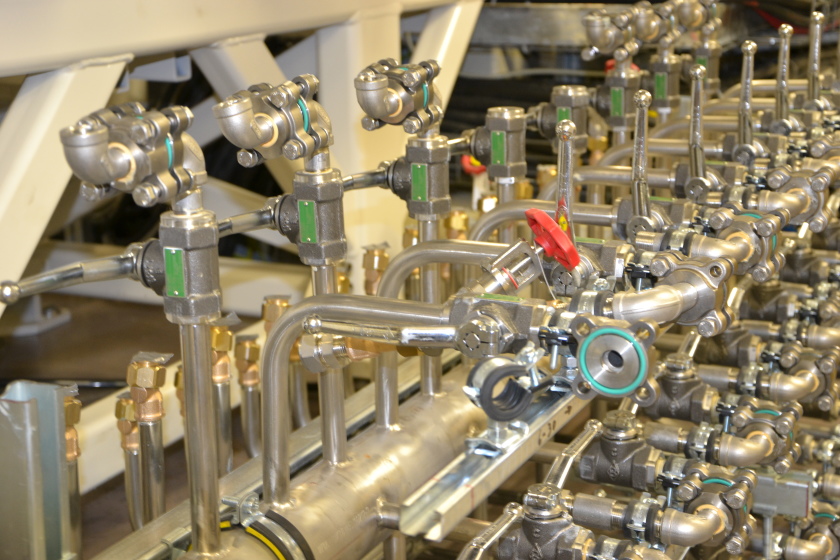New cavities successfully installed

The new cavities during their installation. © C. Jung /HZB

A glimps at the water circuits. © C. Jung / HZB
At the heart of BESSY II are four cavities, hollow resonators, providing the energy that electrons in the storage ring re-absorb after they have released it as light packets. The old cavities were still from the 1970s and were employed at DESY in Hamburg, then at BESSY I, and finally at BESSY II beginning in 1998. “However, the limit of their operating life has been reached”, says Dr. Wolfgang Anders from the HZB Institute of SRF – Science and Technology. Anders, an expert in the field, was responsible for replacing two of the four old cavities with new units during the summer shutdown.
The new cavities have been developed as an EU Project under the supervision of HZB. They are constructed of copper, as before, but have a somewhat more complex shape that is optimised to effectively avoid exciting undesirable oscillations, known as “higher-order modes”. These higher modes are excited by high beam energies and can lead to instabilities.
“The new cavities are significantly more robust and can store up to 80 kilowatts – twice as much as the old cavities. As a result, the requirements for cooling have increased as well”, explains Anders, pointing out the multitude of coolant pipes around the new cavities.
The beam energy at BESSY II is presently still restricted because the vacuum in the new cavities is still improving slowly. “We will be normalising the vacuum conditions over Christmas so that we can operate BESSY II at full beam energy afterwards”, says Anders.
Both of the other old cavities will be replaced during the 2015 summer shutdown so that all the advantages of the new cavities can come into play.
arö
https://www.helmholtz-berlin.de/pubbin/news_seite?nid=13841;sprache=en
- Copy link
-
Ernst Eckhard Koch Prize and Innovation Award on Synchrotron Radiation 2025
At the 27th BESSY@HZB User Meeting, the Friends of HZB honoured the dissertation of Dr Enggar Pramanto Wibowo (Friedrich-Alexander University Erlangen-Nuremberg). The Innovation Award on Synchrotron Radiation 2025 went to Prof. Tim Salditt (Georg-August-University Göttingen) and Professors Danny D. Jonigk and Maximilian Ackermann (both, University Hospital of RWTH Aachen University).
-
Synchrotron radiation sources: toolboxes for quantum technologies
Synchrotron radiation sources generate highly brilliant light pulses, ranging from infrared to hard X-rays, which can be used to gain deep insights into complex materials. An international team has now published an overview on synchrotron methods for the further development of quantum materials and technologies in the journal Advanced Functional Materials: Using concrete examples, they show how these unique tools can help to unlock the potential of quantum technologies such as quantum computing, overcome production barriers and pave the way for future breakthroughs.
-
Peat as a sustainable precursor for fuel cell catalyst materials
Iron-nitrogen-carbon catalysts have the potential to replace the more expensive platinum catalysts currently used in fuel cells. This is shown by a study conducted by researchers from the Helmholtz-Zentrum Berlin (HZB), Physikalisch-Technische Bundesanstalt (PTB) and universities in Tartu and Tallinn, Estonia. At BESSY II, the team observed the formation of complex microstructures within various samples. They then analysed which structural parameters were particularly important for fostering the preferred electrochemical reactions. The raw material for such catalysts is well decomposed peat.
